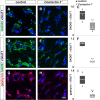TrkB (tropomyosin-related kinase B) controls the assembly and maintenance of GABAergic synapses in the cerebellar cortex
- PMID: 21414899
- PMCID: PMC3154015
- DOI: 10.1523/JNEUROSCI.4991-10.2011
TrkB (tropomyosin-related kinase B) controls the assembly and maintenance of GABAergic synapses in the cerebellar cortex
Abstract
Inhibitory interneurons play a critical role in coordinating the activity of neural circuits. To explore the mechanisms that direct the organization of inhibitory circuits, we analyzed the involvement of tropomyosin-related kinase B (TrkB) in the assembly and maintenance of GABAergic inhibitory synapses between Golgi and granule cells in the mouse cerebellar cortex. We show that TrkB acts directly within each cell-type to regulate synaptic differentiation. TrkB is required not only for assembly, but also maintenance of these synapses and acts, primarily, by regulating the localization of synaptic constituents. Postsynaptically, TrkB controls the localization of a scaffolding protein, gephyrin, but acts at a step subsequent to the localization of a cell adhesion molecule, Neuroligin-2. Importantly, TrkB is required for the localization of an Ig superfamily cell adhesion molecule, Contactin-1, in Golgi and granule cells and the absence of Contactin-1 also results in deficits in inhibitory synaptic development. Thus, our findings demonstrate that TrkB controls the assembly and maintenance of GABAergic synapses and suggest that TrkB functions, in part, through promoting synaptic adhesion.
Figures








Similar articles
-
TrkB receptor signaling is required for establishment of GABAergic synapses in the cerebellum.Nat Neurosci. 2002 Mar;5(3):225-33. doi: 10.1038/nn808. Nat Neurosci. 2002. PMID: 11836532 Free PMC article.
-
GABAergic and glutamatergic terminals differentially influence the organization of GABAergic synapses in rat cerebellar granule cells in vitro.Neuroscience. 2002;114(1):123-33. doi: 10.1016/s0306-4522(02)00206-3. Neuroscience. 2002. PMID: 12207960
-
Glutamatergic axon-derived BDNF controls GABAergic synaptic differentiation in the cerebellum.Sci Rep. 2016 Feb 1;6:20201. doi: 10.1038/srep20201. Sci Rep. 2016. PMID: 26830657 Free PMC article.
-
GABA and neuroligin signaling: linking synaptic activity and adhesion in inhibitory synapse development.Curr Opin Neurobiol. 2008 Feb;18(1):77-83. doi: 10.1016/j.conb.2008.05.008. Epub 2008 May 29. Curr Opin Neurobiol. 2008. PMID: 18513949 Free PMC article. Review.
-
Formation of GABAergic synapses in the cerebellum.Cerebellum. 2005;4(3):171-7. doi: 10.1080/14734220510008012. Cerebellum. 2005. PMID: 16147949 Review.
Cited by
-
Hippocampal parvalbumin interneurons play a critical role in memory development.Cell Rep. 2022 Nov 15;41(7):111643. doi: 10.1016/j.celrep.2022.111643. Cell Rep. 2022. PMID: 36384113 Free PMC article.
-
GABAergic System Dysfunction in Autism Spectrum Disorders.Front Cell Dev Biol. 2022 Feb 7;9:781327. doi: 10.3389/fcell.2021.781327. eCollection 2021. Front Cell Dev Biol. 2022. PMID: 35198562 Free PMC article. Review.
-
Neuroligin-1 dependent phosphotyrosine signaling in excitatory synapse differentiation.Front Mol Neurosci. 2024 May 15;17:1359067. doi: 10.3389/fnmol.2024.1359067. eCollection 2024. Front Mol Neurosci. 2024. PMID: 38813439 Free PMC article.
-
Deletion of TrkB in parvalbumin interneurons alters cortical neural dynamics.J Cell Physiol. 2022 Jan;237(1):949-964. doi: 10.1002/jcp.30571. Epub 2021 Sep 7. J Cell Physiol. 2022. PMID: 34491578 Free PMC article.
-
Increased cortical synaptic activation of TrkB and downstream signaling markers in a mouse model of Down Syndrome.Neurobiol Dis. 2015 May;77:173-90. doi: 10.1016/j.nbd.2015.02.022. Epub 2015 Mar 6. Neurobiol Dis. 2015. PMID: 25753471 Free PMC article.
References
-
- Altman J, Bayer SA. Development of the cerebellar system: in relation to its evolution, structure, and functions. Boca Raton, FL: CRC; 1997.
-
- Ango F, di Cristo G, Higashiyama H, Bennett V, Wu P, Huang ZJ. Ankyrin-based subcellular gradient of neurofascin, an immunoglobulin family protein, directs GABAergic innervation at Purkinje axon initial segment. Cell. 2004;119:257–272. - PubMed
-
- Berglund EO, Ranscht B. Molecular cloning and in situ localization of the human contactin gene (CNTN1) on chromosome 12q11–q12. Genomics. 1994;21:571–582. - PubMed
-
- Berglund EO, Murai KK, Fredette B, Sekerková G, Marturano B, Weber L, Mugnaini E, Ranscht B. Ataxia and abnormal cerebellar microorganization in mice with ablated contactin gene expression. Neuron. 1999;24:739–750. - PubMed
Publication types
MeSH terms
Substances
Grants and funding
LinkOut - more resources
Full Text Sources
Molecular Biology Databases
